
KIDS, RAILROADS, PEOPLE & ACTIVITIES
STORIES OF A SMALL RAILROAD TOWN
IN THE 1930'S, 40'S & 50'S ........... by George
John R. Warren
The articles and pictures that you see within these pages about Bluford
were submitted by Janice Staples
Written permission was given by the author, the late John R. Warren, to use on this website.

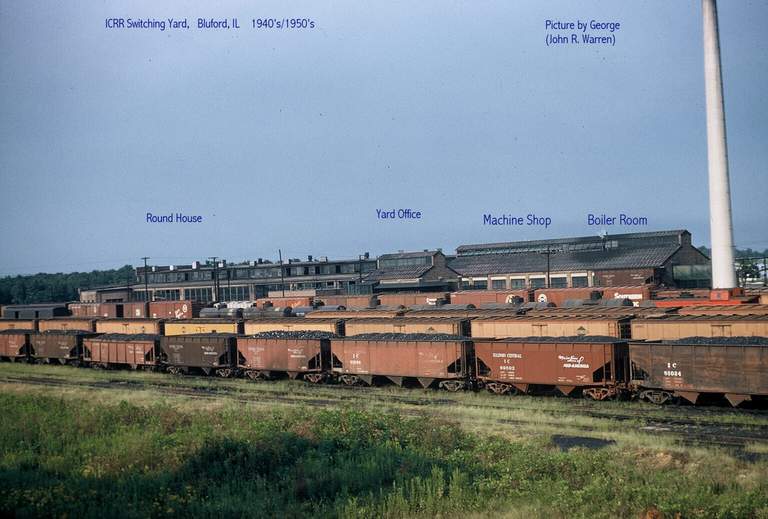
|
The Illinois Central Railroad (ICRR) was chartered in 1851 to build a railroad from Cairo, Illinois, at the ajoining of the Ohio and Mississippi rivers, to Galena, in the extreme northwest corner of of the state (the "Old Main"), with a branch from Centrailia (named for the railroad) to Chicago (the "Chicago Branch"). In 1900 a train wreck at Vaughn, Miss., achieved worldwide fame because an engine-wiper named Wallace Sanders wrote a song about the incident. The engineer, the only person killed, was one John Luther Jones, nicknamed "Casey". In 1928 the railroad constructed a cutoff line between Edgewood, IL and Fulton, KY to bypass congestion at Cairo, the waist of its system. The Bluford Switching Yard, at Bluford, IL, was the hub of the Edgewood cut-off line and activities. The Bluford Yard was active for over 40 years, closing in 1969. The other railroad in Bluford was the Southern RR and it was there long before the ICRR. They say it was originally the "Air Lines" RR, then later was the Southern. It went east/west and had a depot right in the heart of downtown Bluford. Notable ICRR "name" passenger trains:
THE ICRR IN BLUFORD The IC was in Bluford as long as I can remember. The "Edgewood Cut-off" was constructed in 1928. The Bluford Switching Yard was the hub of the Cut-off. It was a freight-switching yard, and there was never any passenger train traffic thru Bluford, except an occassional troop train in WWII, and maybe a few times when there was an accident over on the Mainline. The line that came through Bluford was called the Edgewood Cut-off, because it started iat Edgewood, IL about 15 miles south of Effingham, and went on to Fulton KY. For reference, Effingham was 199 and Edgewood was 214. Those numbers are miles from Chicago, going south. Then Edgewood was also mile 0 at the start of the cut-off and Bluford was 42, on the cut-off. Fulton was 127 miles from Bluford, which was the south end of the cut-off. There was also a branch from Bluford that went to Paducah. The ICRR Mainline went on from Edgewood to Centralia, thru Carbondale, thru Cairo, and on down to Fulton. Centralia and Cairo (Mounds) had their own switching yards and the Bluford yard took some of their business after it was constructed and activated. Although freight trains still go thru Bluford, on the Edgewood Cut-off, switching ceased in the late 60's and the excitement and glamour of the old Bluford Yards, now exists only in our aging memories. SWITCHING YARDS Now why was there a need for switchings yards in the first place? Well back in the '30's and on thru the '50's, most of the country's freight was carried by rail. Remember there were no Interstate Highways or 18-wheelers back then. Freight came from various sources, such as manufacturing plants' shipping docks. About every plant that produced or assembled products for sale, had "rail spurs", coming into their area from one or more railroads. Coal mines loaded coal cars or "hopper" cars with coal. Oil companies shipped tank cars of oil. Manufacturing companies shipped their products via rail. New autos from Detroit were shipped in "auto cars" or "auto rack cars". Bananas were unloaded from big boats on the Gulf Coast. They could fill numerous, maybe 50 or more, refrigerator (reefer) cars with bananas. There were also flat cars and the ubiquitous boxcars. Empty cars would be placed on the spurs by the loading docks of companies. When filled with a product, loaded cars were taken from the spurs and eventually ended up on the train, headed toward their destination. As you would expect, the cars picked up might be going to practically any place in the country. The shippers were the companies that were shipping something and the carriers were the railroads that would be "carrying" the freight, or moving it by train. Thus when cars were "picked up", they would have various destinations and routes by rail to travel, to get to those destinations. After these cars were picked up by the carriers, or railroads, they would end up on a train, on the first leg of their journey to their destination. THE BLUFORD SWITCHING YARD LAYOUT: The Bluford ICRR switching yard had 15 switching tracks, plus 2 Ice House tracks, a "thoroughfare" track, the main line track, 4 Rip (repair) tracks, 4 "A yard" tracks, which were south of the main yard tracks and used to overflow times of heavy rail traffic,some "roundhouse tracks", and probably a few more that I don't recall, but those are the main ones. It could handle an amazing amount of rail traffic and was often stretched to the limit during WWII and sometimes after that. The longest switching track was #1 and they got progressivly shorter going on to #15. I think #1 could handle about 150 cars -- if those cars were hopper cars. Hoppers are shorter than others. Track #8 could handle about 100. Since tracks were used for switching and train building purposes at both the north end and south end of the yards, it was necessary to coordinate and keep in touch with what each end was doing to prevent running into each other while conducting their seperate switching operations. The ice house tracks were used for trains, often "hot-shot" freights that would usually have perishable goods needing ice and often for banana trains in the summer, when it was reasonably sure that they would need icing. The viaduct over the ICRR has been in it's present location for a long time now, on the road that goes right by Doc Goodrich's home. Before it was built, there was a viaduct on the road that comes from the west and goes right in front of DeWitt's store location. That road just went on east then, to the viaduct over the tracks. It seemed like a long ways to go around after they built the new one and took the old one out. Earl Thomason said that it was done so that they could get rid of the "hill" on the west side of the old viaduct, so that the switch engine engineer could see the switchman's signals. When it was there, they had to have an extra switchman down there by it, just to pass on the lantern or hand signals from the engine foreman to the engineer. I had always thought they had expanded the yards a little bit in that area and needed to move it because of that , but Earl told me that signal visibility was the reason. 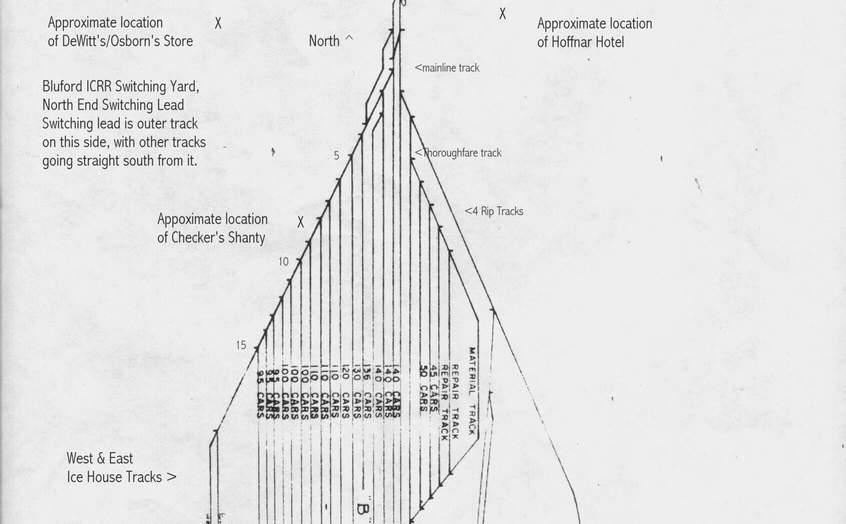
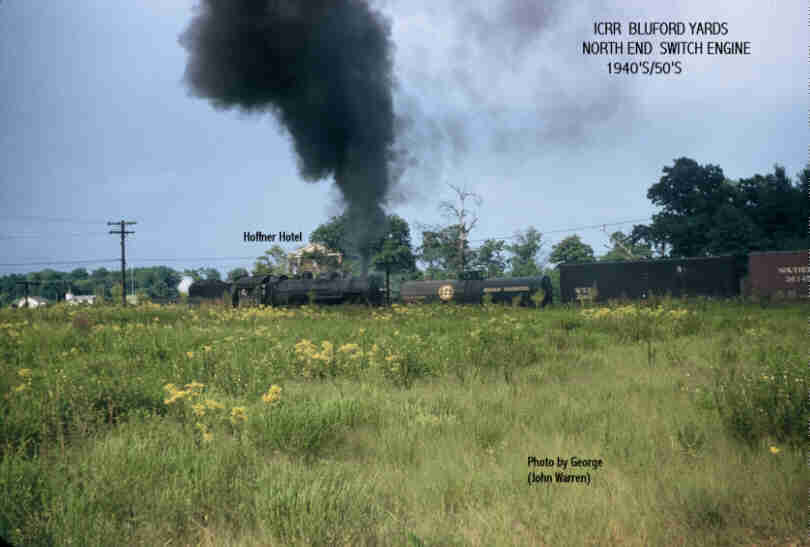
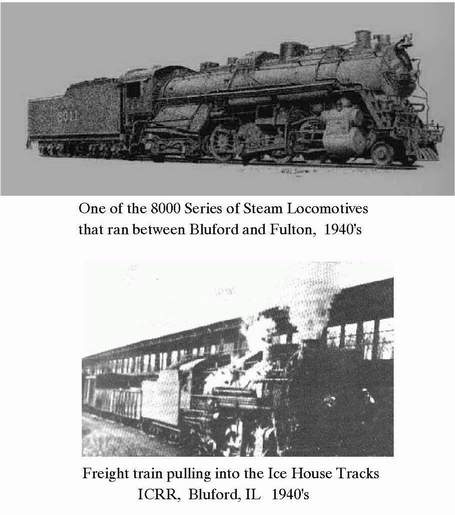
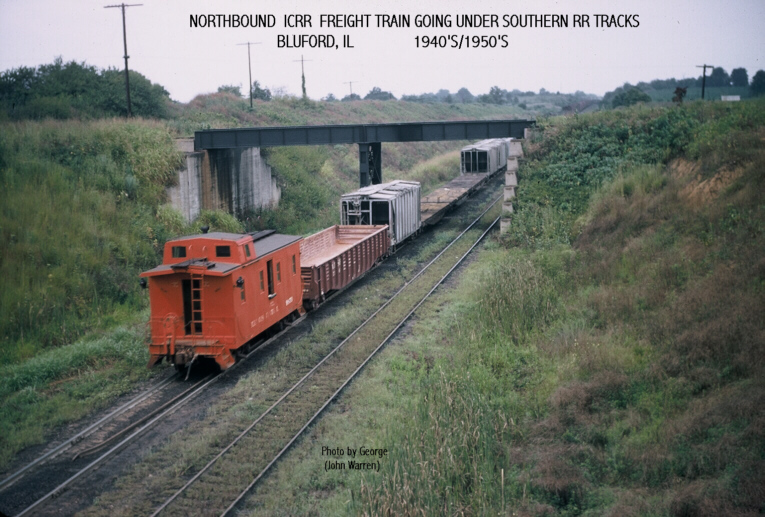
|
For corrections or additions, please contact me: Sandy Bauer